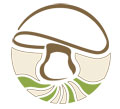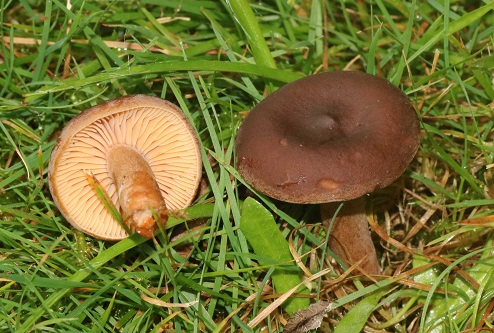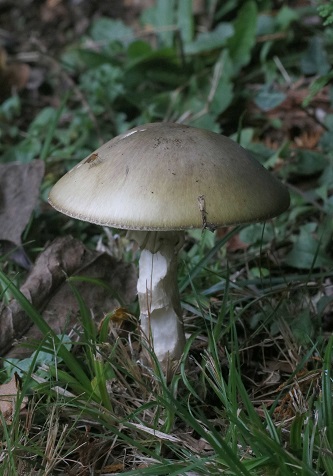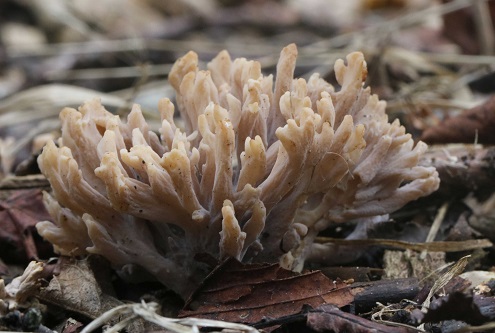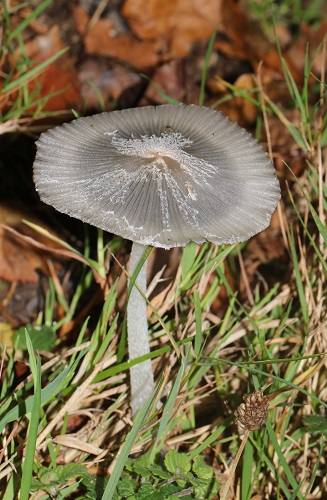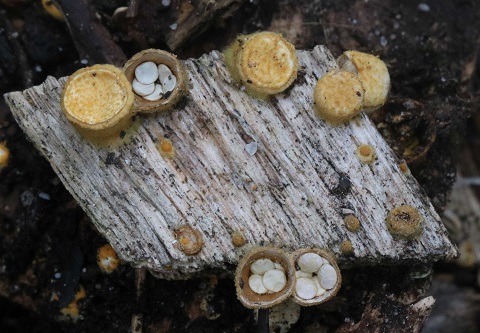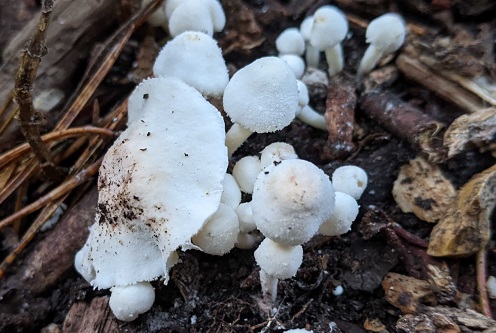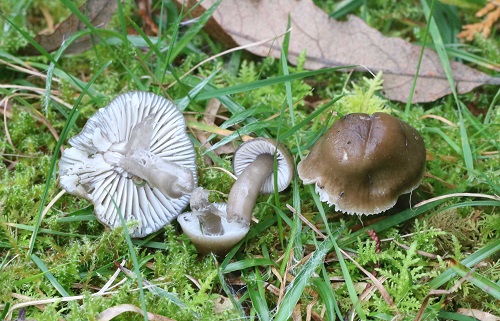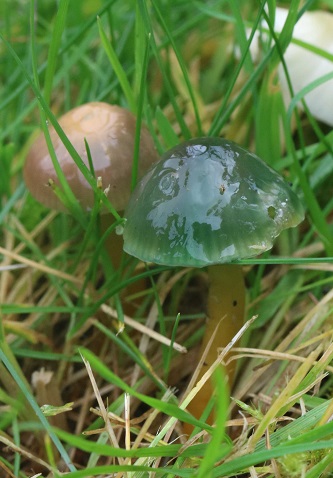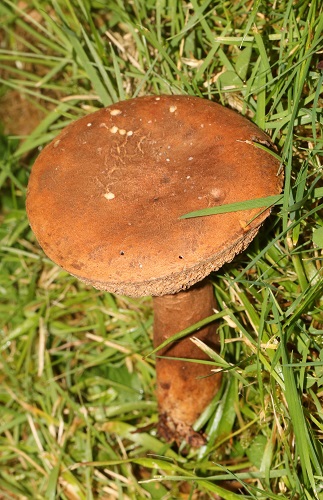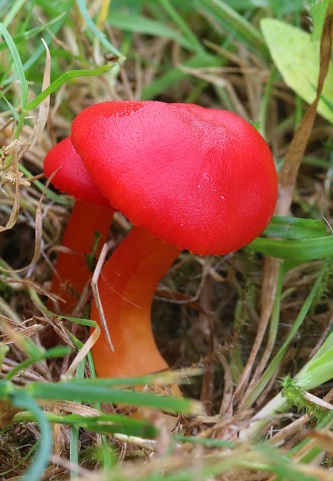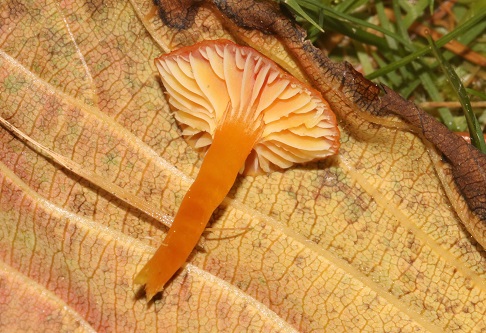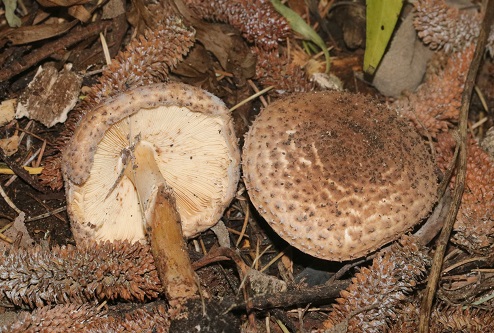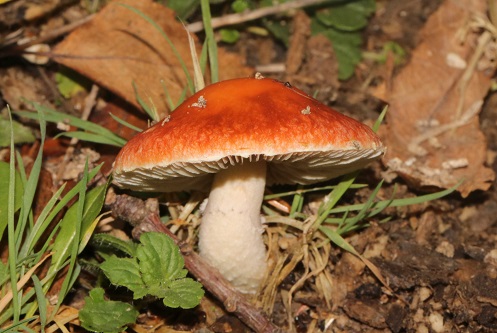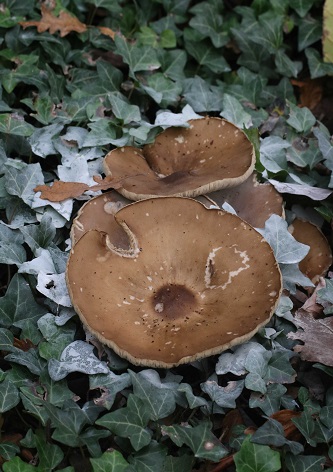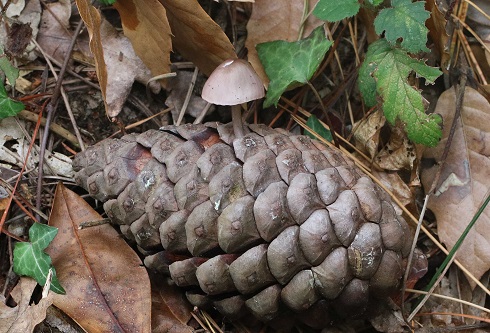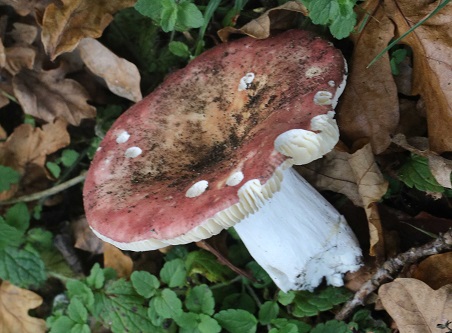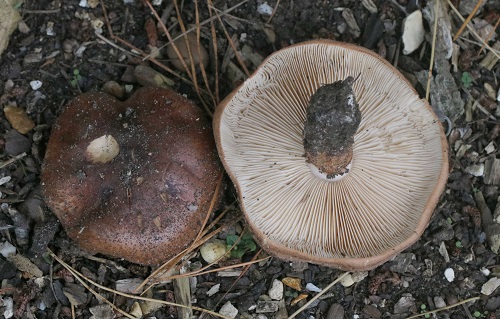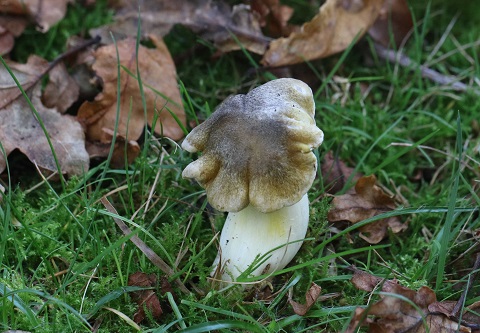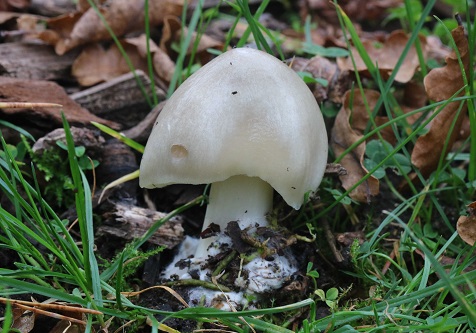Exbury
Sun 14 Nov 2021
Field event ID HF2128
OS Grid areas: SU4200
Report: This is always one of the most eagerly awaited forays of the year which guaranteed another large turnout of members. The weather was mild and overcast with a cool northerly breeze in unsheltered spots.
Once again, the gardens lived up to expectations. Early finds included Coprinopsis lagopus (Hare’s Foot Inkcap), Xerula radicata (Rooting Shank), Macrocystidia cucumis (Cucumber Cap), Leratiomyces ceres (Redlead Roundhead) and the earthtongue, Geoglossum umbratile (Plain Earthtongue).
As we moved onto the extensive lawns we found a smattering of waxcaps including Hygrocybe conica (Blackening Waxcap), Hygrocybe virginea (Snowy Waxcap) and Hygrocybe russocoriacea (Cedarwood Waxcap) as well as Clitocybe geotropa (Trooping Funnel), a rather worn specimen of Gyroporus castaneus (Chestnut Bolete) and Inocybe asterospora (Star Fibrecap).
Moving on into an area of pines, we stumbled on the first of several fine specimens of Amanita phalloides (Deathcap) and the uncommon Mycena seynii (Pine Cone Bonnet). A young bracket was thought to be Ischnoderma benzoinum (Benzoin Bracket).
We progressed on to the shrubbery borders where Clitocybe fragrans (Fragrant Funnel) and the umbonate Russula caerulea (Humpback Brittlegill) were seen.
Crossing another lawn produced Cystoderma amaianthinum (Earthy Powdercap), Lactarius subumbonatus (Watery Milkcap) and the waxcap species, Hygrocybe insipida (Spangle Waxcap), Hygrocybe coccinea (Scarlet Waxcap), Gliophorus psittacina (Parrot Waxcap), and the distinctive brown Gliophorus irrigatus (Slimy Waxcap).
The mulch beds of the borders are often good hunting grounds and the first revealed Clavulina cinerea (Grey Coral) and a specimen of Phallus impudicus (Stinkhorn) which was still attracting good numbers of flies despite most of the pungent gleba having already been consumed. This was soon followed by the discovery of two species of the diminutive but fascinating bird’s nest fungi. Cyathus striatus (Fluted Bird’s Nest) was found in quantity but most of the spore-bearing ‘eggs’ (peridoles) had already been expelled and dispersed from the ‘nests’ by raindrops. Not so with the fresher second species, Crucibulum laeve (Common Bird’s Nest), many of which were still covered by the protective yellow veil which gives them the look of minute souffles. Where the covering had broken away, the ‘nests’ contained up to 10 whitish ‘eggs’ (peridoles).
Further discoveries in the flowerbeds included two species of Tricholoma; T. terreum (Grey Knight) and the less common T. imbricatum (Matt Knight) as well as Lepiota aspera (Freckled Dapperling).
After an absorbing morning we made a lunch-stop but even here the recording continued with some fine specimens of Russula sanguinaria (Bloody Brittlegill) being found on the grass in front of the toilet block!
The afternoon session began with Russula puellaris (Yellowing Brittlegill) and Inocybe geophylla var. lilacina (White Fibrecap). A popular find was Cordyceps militaris (Scarlet Caterpillarclub) and, nearby, Volvariella gloiocephala (Stubble Rosegill).
Hidden under some shrubs a Melanoleuca species (Cavalier sp.) had given the ivy growing beneath it a dramatic dusting of white spores. A mauve Russula species that made it into Eric’s collecting box, proved to be Russula decipiens.
The final area of grassland that we explored rewarded us with Tricholoma sejunctum (Deceiving Knight) whilst a border on our return contained the probable Cystolepiota seminuda (Bearded Dapperling).
The site had provided us with another fascinating day and only failing light and the need to lock the gates brought it to an end.
Species recorded: Agaricus arvensis, Amanita citrina var. citrina, Amanita muscaria var. muscaria, Amanita phalloides, Amanita rubescens var. rubescens, Armillaria mellea, Bjerkandera adusta, Boletus chrysenteron, Boletus edulis, Byssomerulius corium, Clavulina cinerea, Clavulinopsis helvola, Clavulinopsis luteoalba, Clitocybe fragrans, Clitocybe geotropa, Clitocybe nebularis, Clitopilus prunulus, Coprinellus micaceus, Coprinopsis lagopus, Cordyceps militaris, Cortinarius rubricosus, Crucibulum laeve, Cyathus striatus, Echinoderma asperum, Geoglossum umbratile, Gliophorus irrigatus, Gliophorus psittacinus, Gymnopilus penetrans, Gyroporus castaneus, Helvella crispa, Helvella lacunosa, Hygrocybe conica, Hygrocybe insipida, Hygrocybe russocoriacea, Hygrocybe virginea var. virginea, Hypholoma fasciculare var. fasciculare, Inocybe asterospora, Inocybe cincinnata var. major, Inocybe geophylla var. lilacina, Inocybe griseolilacina, Laccaria amethystina, Laccaria laccata, Laccaria proxima, Lactarius chrysorrheus, Lactarius hepaticus, Lactarius quietus, Lactarius subumbonatus, Lepiota cristata, Lepista nuda, Leratiomyces ceres, Lycoperdon pratense, Lycoperdon pyriforme, Macrocystidia cucumis, Macrolepiota procera var. procera, Melanoleuca grammopodia, Mycena acicula, Mycena epipterygia, Mycena filopes, Mycena galericulata, Mycena haematopus, Mycena pelianthina, Mycena rosea, Mycena seynii, Mycena stylobates, Otidea alutacea, Otidea onotica, Panaeolus acuminatus, Phallus impudicus var. impudicus, Pholiota squarrosa, Pluteus cervinus, Psathyrella microrhiza, Rhodocollybia butyracea, Russula acetolens, Russula aeruginea, Russula atropurpurea, Russula decipiens, Russula delica, Russula fellea, Russula fragilis var. fragilis, Russula grisea, Russula nigricans, Russula nobilis, Russula ochroleuca, Russula parazurea, Russula praetervisa, Russula puellaris, Russula sanguinaria, Scleroderma citrinum, Sparassis crispa, Trichaptum abietinum, Tricholoma imbricatum, Tricholoma sulphureum var. sulphureum, Tricholoma terreum, Tubaria conspersa, Tubaria furfuracea, Volvariella gloiocephala, Xerula radicata, Xylaria hypoxylon
A full species list with further details can be seen at the Fungal Records Database of Britain and Ireland (FRDBI). Please contact us if you need a user ID.
